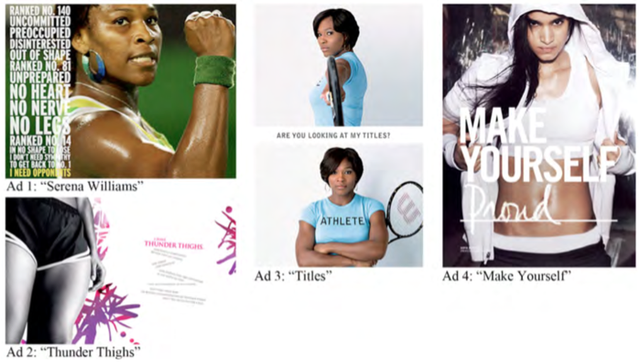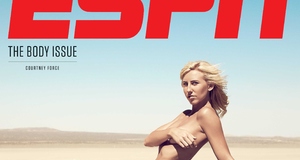From Elon Journal of Undergraduate Research in Communications VOL. 4 NO. 2Testing the Appeals of Feminist Ideologies in Female Athletic Advertising
IN THIS ARTICLE
KEYWORDS
AbstractThe purpose of this study was to determine whether Generation Y women respond more to athletic ads that embodied a second-wave feminist ideology or a third-wave, post-structuralist ideology. A focus group was conducted and its findings revealed that the women's ideological preferences were not based on their generation, but their lifestyle. In other words, the Generation Y women did not unanimously identify with one feminist ideology over the other. Instead, the ideology they responded to in the athletic ads was based on their athletic lifestyle. This ultimately indicates that Generation Y females are segmented, and each market segment responds to ads that present a lifestyle and values similar to their own. The implications found in this research may be used to provide consumer insights to professionals in the advertising industry. I. IntroductionSecondand third-wave feminist ideologies helped advertisers determine the values and preferences of women in each generation. By understanding what women responded to, advertisers produce images and copy that engaged their female audiences. A new wave of feminism has yet to emerge, and its absence contributes to the lack of insight into the ideology that appeals most to female Generation Y** consumers. Secondand third-wave feminism, although still relevant now, can both be associated with a generation of women. Generation Y has the two conflicting ideologies of the past, making it difficult to determine which, if either, mindset reigns supreme among today's early adult, female consumers. This research aims to determine if Generation Y women respond more positively to second-wave or third-wave feminist ideology in athletic advertising. The studies in this investigation identify the characteristics of female athletic advertisements that appeal to Generation Y women and their corresponding ideologies. Athletic advertising has been selected because the athletic-wear industry was one of the many markets affected by feminist movements and trends. Brands such as Nike were strictly masculine and did not begin adding women's lines until the end of the 1980s (Grow & Wolburg, 2006). Since then, some brands have produced women's ads similar to their men's ads – taking a more second-wave, gender-neutral approach to advertising to their female audience. Others have catered specifically to third-wave, feminine sensibilities. The findings included in this research are intended to help athletic advertisers understand to which feminist ideology female Generation Y consumers relate most. (Generation Y, for the purposes of this study, is defined as the demographic born between 1984 and 2000 and is also known as the Millennial Generation - see Mashable, 2013.) The information garnered from this study will help these advertisers better tailor their messages to fit this demographic. II. Literature ReviewBackground TheoryMarket segmentation is changing the way in which advertisers reach audiences, especially women. Females have long been considered one "homogeneous category" (Scott, 2008). Now, with markets growing increasingly segmented, targeting such a broad audience is ineffective. As Janet Riccio, CEO of the women's consultancy G23, notes that marketing just to "women" is a bankrupt concept – "it's very paternalistic . . . far too passive for the women of the 21st century and seems to be code for 'marketing to moms.' Women are other things besides moms" (Scott, 2008). As advertisers begin to specify and segment female markets, the challenge becomes how to effectively communicate with each target audience. A study of women's responses to different portrayals of females in advertisements demonstrates the value behind segment-specific messaging. Although performed over 20 years ago, the findings from this study still apply to today's advertising industry. Researchers tested women's reactions on a cognitive response level to understand how the "spontaneous thoughts of the audience to an ad influence the audience's attitude toward the ad and the product" (Leigh, Rethans, & Whitney, 1987, p. 55). As the basis for their experiment, Leigh, Rethans, and Whitney (1987) examined the relationship between role orientation – a woman's beliefs about the lifestyles and place of women in society – and role portrayal, the "characterizations of people in commercials as well as their setting relative to the product and other characters" (p. 56). In 1987, when women were still grouped into broader audience categories, the researchers tested the different reactions traditional and modern women had to traditional and modern role portrayals of women in advertisements. To gauge the respondents' cognitive responses, they measured the different groups' "attitude toward the advertisement, the role model (or source), the brand, and the act of buying the brand" (p. 56). They found that traditional women responded strongest to ads with traditional role portrayals of women. Likewise, modern women related best to the ads featuring women in modern roles. In other words, women responded to the role portrayal that was consistent with how they saw themselves and their role orientation. It follows then, that effective advertising maintains consistency between the role portrayal of females and the target audience's role orientation or general values. The findings from this study ultimately indicate that ad context and messaging must align with the views of the target audience. A harmonious matching of female portrayal to audience expectations yields positive viewer responses and influences, among other things, their consideration and/or purchasing of the product and their opinion of the ad's effectiveness. (Leigh et al, 1987, pp. 54-55; Scott, 2008). Researchers found that messaging needs to be segment-specific to effectively influence an audience's perception of the product and brand. Once the modern women identified the traditional women in the test ad as "housewives" they tuned out the ad completely (Leigh et al, 1987, p. 58), indicating the negative result of a role portrayal inconsistent with the target audience. Overall, the results "confirm the market segmentation view that communications effectiveness is enhanced by tailoring that advertisement . . . to the target audience" (p. 60). The ads whose context matches the views of the market segment will be the most effective. Furthermore, as Riccio found in her survey of women around the world, "there is power to be had in the intersection of a product... and the needs or values of women and girls in your target customer group" (Scott, 2008). Advertising today does not solely focus on selling the product, however. Ads help construct consumer product preferences, establish a brand's identity, and likewise, influence the audience's perception of the brand as a whole. The postmodern branding theory identifies brands as more than a collection of products; brands are an entity of their own. They are living things with sacred identities and are full of emotional promises (Grow, 2008, p. 314). A compelling brand and its advertising "recognizes there are fundamental human truths and needs that it can uniquely serve" (Grow, 2008, p. 315) and communicates those qualities in a way that resonates with its target market. In short, ad context influences the audience's perception of both the individual product and of the brand in general. For this reason, it is imperative that ads accurately appeal to the intended audience. Feminism and AdvertisingThe rise of second-wave feminism in the later 20th century helped define a generation of women and their preferences. The driving women behind this movement, such as Betty Friedan and Gloria Steinem, sought to liberate women from the constraining gender roles and gender discrimination of the patriarchal culture in which they lived (Skinner, 2009, p. 9). Second-wave feminists addressed the primary issue of role equality, while arguing that "gender roles and gender behaviors . . . inherently disadvantaged women" (Skinner, 2009, p. 12). These women shaped the second-wave through their efforts to "break through the oppression of women" (Mack-Canty, 2004, p. 157) and incite a change in "traditional" gender roles that would ultimately affect societal gender norms (Skinner, 2009, p. 13). Essentially, the second-wave feminists saw no "difference between women and men, other than the superficial one of having been treated differently" (MackCanty, 2004, p. 157). They rallied for images, especially in advertising, that portrayed women as more than housewives and positioned them as equals to men (Skinner, 2009, p. 12). Second-wave women wanted "egalitarian representations of women [and] . . . texts more respectful of women's intelligence, paired with images more reflective of their diverse roles" (Howard, 2010, p. 142). As Steinem and her editors at Ms. Magazine explained, "We don't' spend half our money on makeup . . . and the other half on food . . . we also buy cars, books, airline tickets . . . and the many products that aren't usually directed to women at all" (Howard, 2010, p. 139). These demands changed advertisers' perceptions of the "American woman consumer" and how they targeted female audiences (Howard, 2010, p. 137). Effective advertising gave women what they wanted; it valued the female consumer and portrayed women in roles more similar to men. Third-wave, post-structuralist feminism – the ideology born in the late 1980s and early 1990s – embodied a different set of values. Unlike second-wave feminist ideology, which referred to women as a singular group and assumed "a universalization of their experiences as 'women's experience,'" third-wave acknowledged the diversity in experiences and views among women (Howard, 2010, pp. 158-159). Third-wave feminists continued the second-wave's resistance against hegemonic gender roles and a patriarchal culture. Yet, these feminists did not see gender neutrality as synonymous with gender equality and encouraged women to own their femininity and "re-appropriate their girlhood" into a means of rebellion and empowerment (p. 162). In summary, the third-wave ideology promotes individuality and the sharing of female experiences among women. During this movement, effective advertising meant presenting images of women who were empowered by their femininity, and copy where these women shared a story. III. MethodologyThe purpose of this study is to determine if Generation Y women respond more positively to secondwave or third-wave feminist ideologies in athletic advertising. A focus group was conducted to gain insight from female Generation Y consumers who purchase athletic gear. A focus group was the most appropriate research method for this study because it helps measure participants' reactions and gauges their attitudes, perceptions, and thought processes to a particular subject (Krueger & Casey, 2000, p.4, 12). Ultimately, a focus group was the most effective method of determining the participants' opinions (p. 12) on the ads presented and questions posed during the discussion. SampleA focus group of six Generation Y women was conducted for this purpose. The participants in this focus group were selected based on a convenience sample in an effort to gain input from a variety of women, and also due to time constraints. To protect the confidentiality of the focus group, the participants will be referred to as participants 1-6.
ProcedureThe focus group was conducted on April 10, 2013. The six participants sat around a table and introduced themselves by age, regularity and type of athletic activity, and whether or not they would consider themselves an athlete. From their introductions, two types of participants emerged: higher-impact athletes and lower-impact athletes. On the spectrum of high to low, participants 1 and 2 were high impact athletes, participants 3 and 4 were low impact athletes, and participants 5 and 6 were in the middle, leaning more to the lower end. A script guided the focus group and posed discussion topics to gain insight toward the following research questions:
The focus group began with broader discussion topics regarding the participants' opinions about what appealed to them in ads. The participants discussed some values-based questions about the impact a woman's portrayal in an ad has on them, if a woman's portrayal affects their purchasing decisions, and if the portrayal of a woman influences their greater perception of the brand. From there, the discussion began to narrow and focused on identifying the characteristics in athletic ads that appealed to the participants. The participants were given four advertisements to discuss. To avoid any brand bias, the test advertisements were from different campaigns done by Nike. All logos and mention of a specific product or of Nike itself were removed in Photoshop so that the participants would react solely to the ad content.
The next part of the discussion was focused on the participants' responses to the test ads – how they would describe the women in each ad, the idea they saw each ad presenting, and how the portrayal of each woman affected their perceptions of the overall ad. The participants also highlighted the most impactful characteristics in each ad. Participants then selected the ad that appealed to them the most and shared their reasoning behind why the ad appealed to them and went more in-depth about what made them connect to it. They ended by determining whether the ad would compel them to purchase a product from the brand. The focus group discussion was recorded, transcribed, and then coded to identify trends in the participants' responses and attitudes toward the four ads. The discussion was guided in hopes of determining whether Generation Y females responded more to ads that had characteristics of second-wave feminist ideology or ads that embodied more third-wave values. The responses, however, did not fit into a binary of pro-second-wave or pro-third-wave. Since the majority did not clearly lean toward one ideology over the other, the content needed to be analyzed using a more "who" and "why" approach. A basic typology was employed first, to group the respondents into two categories based on their professed level of athleticism or athletic activity. Each participant was either a high-impact athlete or a low-impact athlete, based on the distinctions provided earlier in this section. A content analysis was then performed to identify which category of respondents had responded most favorably to each ad. Given that each ad represented either secondor third-wave feminist ideology, analyzing the responses high-impact and low-impact women gave to the ads would identify any correlations between consumer type and feminist ideology. The responses to each ad were separated out and color-coded to identify the reactions from highand low-impact athletes. Under each ad were lines of pink (low-impact) and purple (high-impact) responses to show respondent preferences and to distinguish opinions. "Serena Williams" and "Thunder Thighs," the opposite ends of the feminist ideology spectrum, garnered the most responses. The responses to each of these ads were then analyzed for content to determine the values each respondent category had expressed. In other words, the content was analyzed to understand who favored each ad and why. The patterns that emerged during this coding process revealed relationships between types of athletes and their underlying ideology preferences.Continued on Next Page » Suggested Reading from Inquiries Journal
Inquiries Journal provides undergraduate and graduate students around the world a platform for the wide dissemination of academic work over a range of core disciplines. Representing the work of students from hundreds of institutions around the globe, Inquiries Journal's large database of academic articles is completely free. Learn more | Blog | Submit Latest in Business & Communications |




















